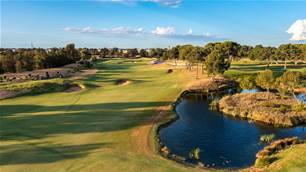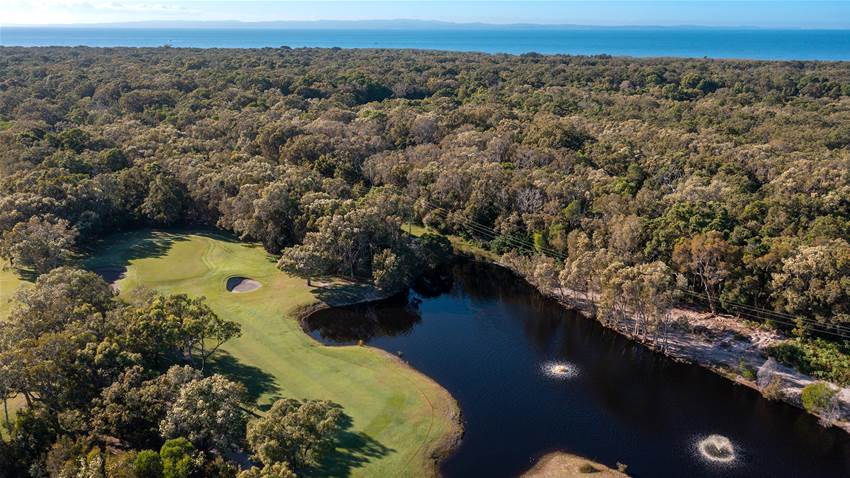La Nina wreaked havoc right along the east coast of Australia at different times during 2022.
Record rainfalls leading to widespread flooding across a host of regions were encountered from as far afield as NSW’s south coast and Queensland’s Fraser Coast, as well as most places in between. Few, if any, east coast golf courses escaped the deluge with some being forced to close for weeks on end to allow floodwater to subside and clean-up work to take place.
Even Bribie Island Golf Club – a 70-minute drive north of Brisbane’s CBD – unbelievably had to close as a river of floodwater cut through the course. I say “unbelievably” because this par-72 lies entirely on a seemingly endless profile of fine sand, which is not surprising given most of the 360 islands of Moreton Bay are all sand. Flooding on natural surfaces on any of these islands is a rarity.
But not even the usually quick-drying, weather resistant Bribie course could hold back 1,400mm of rain across a few days earlier this year. When I visited the course in August to compile this feature, there were still some low points between some holes that looked like exposed wetlands.
In the aftermath of the La Nina event, the club decided to take the opportunity to use tonnes of its greatest resource, sand, extracted during the expansion and clearing of one of its main water hazards to build up, and add some movement to, some of its fairways.
“We had storm and flood events in February-March and again in April, which was a top up,” says club manager, Steve Middleton.
“When you receive your annual rainfall in the space of three days, something has to give. We were closed for five weeks due to water not being able to get away. The water usually drains downwards through the sand, but a higher-than-normal water table left the water nowhere to go.

“We have, and will continue to, put a lot of work into removing the water and elevating a lot of the low-lying areas to avoid a long closure should this ever happen again … and it will.
“On the positive side, we will gain some great new water features that will only improve the golfing experience here.”
When these repairs and upgrade renovations finish bedding in, it will be one of the most significant changes to the course in its 53-year history.
 Back in the 1960s there were less than 4,000 houses on the island, which was only connected to the mainland by bridge in 1963. And there was no golf course.
Back in the 1960s there were less than 4,000 houses on the island, which was only connected to the mainland by bridge in 1963. And there was no golf course.
RIGHT: The final approach to the tiered green on the short par-5 3rd hole. PHOTO: Brendan James.
The idea of a Bribie Island course was born during a Saturday afternoon drive home from a round of golf at Caboolture Golf Club in early 1969. Then island pharmacist, Don Mullen, and Bribie’s police Sergeant, Jim Jeppesen, decided to rustle up interest in establishing the island’s first golf course.
Not long after, the land where the course lies today was identified by long-time professional at Brisbane’s Gailes GC, Arch McArthur, as being ideal for golf.
McArthur had advised many clubs, throughout northern NSW and Queensland, on course design since arriving in Australia from Scotland in the mid 1920s. At Bribie, he adored the sandy loam, and the movement of the terrain, reminiscing of how it reminded him of the links land of home.
"I love the challenge of Bribie Island. The wind blows fairly consistently here, which adds to the test as most holes are densely lined by tall timbers and you don’t always feel exactly what the breeze is doing.” – Top-100 judge, Joe Thomas.
McArthur walked the property many times before providing a rough sketch showing the desired shape and dimensions of the first nine holes. Construction began in October 1969 with shapers ensuring they preserved the natural contours of the low sand dunes that covered the landscape.
Less than a year after brainstorming the idea, Mullen and the founding members played the course for the first time.
By the end of the 1970s, the layout was extended to 18 holes and changes made to McArthur’s original ‘rough’ sketch design to more closely resemble the course that presents today and is ranked No.79 in the Top-100 Public Access Courses in Australia.

“What an eye-opener this course was. I travelled to Bribie Island to play Pacific Harbour and added a round here and was blown away by how good it was,” said Top-100 ranking judge, Tristan Holmes. “Laid out on rolling terrain, there are hints of the Melbourne Sandbelt in the bunkering and the sandy lies off the fairway. You could never get bored playing here week after week.”
Fellow judge Joe Thomas added: “I love the challenge of Bribie Island. The wind blows fairly consistently here, which adds to the test as most holes are densely lined by tall timbers and you don’t always feel exactly what the breeze is doing.”
The round opens with a terrific medium-length par-4 that is dominated by the largest bunker on the course. At 349 metres from the tips, the 1st doglegs right with the corner being close enough to entice longer hitters to cut it with their drive and avoid the massive sand trap that cuts into the fairway from the left. More sand awaits beside the green, with three bunkers – two right and one left – pinching in the sides of the sloping putting surface.
The first genuine birdie opportunity of the round looms at the short par-5 3rd hole, which measures 436 metres from the back pegs and is more demanding of accuracy than power from the tee. If you can avoid the lone fairway bunker down the left, and can keep your ball out of the trees to the right of the narrow driving zone, you will have a great chance of getting close to the green in two blows to set up a birdie. Two greenside bunkers are of concern but the challenge here is ensuring your ball finishes on the same tier as the flag to leave a makeable putt.

One of the lasting impressions I have of Bribie is the high quality of the finishing quartet of holes. The variety is first rate – two short par-4s, a testing par-3 and an interesting par-5 – which I have no doubt lead to a plethora of wildly different scores in the final gasps of a round.
The 329-metre 15th hole is quite a sharp dogleg right that is open to a variety of different clubs being used from the tee as long as you are long enough to reach the corner and have a sight of the green. Cutting the corner with a driver is high risk but, if successful, will leave a short iron or wedge for the second shot into green. However, hitting through the dogleg brings a lake, to be found beyond the tree line, into play.
Water is the dominant feature at the next, where a long water carry from the back markers awaits on the toughest of Bribie’s par-3s. The green on the 172-metre hole sits slightly above the fairway and is protected by a bunker short right and another to the left side of the angled putting surface.

For mine, the best of the closing sequence comes at the final hole – a 335-metre par-4 that turns ever so slightly from right-to-left over a small rise in the fairway. There is a fairway bunker obscured from view on the left here, which is reachable for bigger hitters. The longest of drivers, in some conditions, might even find themselves hitting into another huge sprawling bunker that can be reached about 50 metres short right of the front edge of the green, which slopes markedly from back-to-front.
From humble beginnings as a rough pencil sketch on a single piece of paper, Bribie Island has evolved into a wonderful course that presents a fun and challenging test of golf.
FACT FILE
LOCATION: Links Court, Woorim, Bribie Island, Queensland
 CONTACT: (07) 3408 1457
CONTACT: (07) 3408 1457
WEBSITE: www.bribiegolf.com.au
DESIGNER: Arch McArthur (1969).
PLAYING SURFACES: Bermuda 328 Tifgreen (greens), Queensland Blue couch (fairways).
COURSE SUPERINTENDENT: Mitch Adair.
PGA PROFESSIONALS: Brayden Campbell (head professional), Tom Parchimowicz, Ben Hollis, Jessika Knight.
GREEN FEE: $50 (seven days). Carts $40.
MEMBERSHIP: Membership is available across a wide range of categories – Full Access membership is $1,175, Nine-Hole $740 and Limited Playing is $365. The membership year is January 1 to December 31, so these fees are pro-rated. Check the club’s website for full details.
ACCOMMODATION: The club has stay and play packages with the nearby Fairways Golf & Beach Retreat – www.fairwaysretreat.com.au – as well as the On The Beach Resort – www.onthebeachresort.com.au
ACCOLADES: Ranked No.79 in Golf Australia Magazine’s Top-100 Public Access Courses in Australia for 2021.
Related Articles

Review: Omaha Beach Golf Club

Review: Glenelg Golf Club












